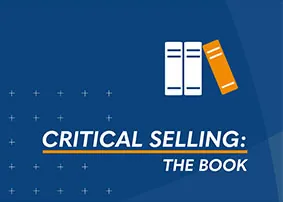Sales Clichés and Bad Sales Habits to Avoid Like the Plague So You Don’t Ruin The Deal

Recently I saw a post on LinkedIn that proclaimed to be a “game-changing, disruptive and transformative solution.” I was not surprised to see a post using the “game-changing” sales cliché with zero likes and zero comments. Sales clichés are ineffective if you are the seller and frustrating if you are the buyer. Sales clichés are a mental crutch that causes both parties to suffer. Most of the time, sales reps use clichés out of habit, without thinking about the negative consequences on their reputation with the prospect. In this article, we will explore the negative impact of using sales clichés, the three sales clichés to avoid, and alternative phrases to improve your sales conversation.
Why Clichés Are Toxic
Every communication with a prospect, whether verbal or written, is either moving you closer to the sale or further away from it. In other words, there are no neutral messages. Clichés are not just inefficient, because they waste the prospect’s time, but they take away from the seller’s credibility. Modern selling is about building trust. Trust is earned by sharing information your prospect views as valuable, not what you think sounds smooth. When a prospect hears a sales cliché, their eyes glaze over and they stop paying attention. If prospects are not paying attention to your communication, there is little chance they will pay anything for your product or solution.
Sales clichés are not just bad communication habits that affect the purchase decision, they also signal a lack of insight from the sales rep. Sellers use clichés because they want to make a point that the buyer will grasp. For example, “Killing two birds with one stone.” But on a sales call with a new prospect, using a sales cliché just shows a lack of empathy for the buyer. Think about what goes through your prospect’s head when they read this tired sales cliché, “let’s jump on a quick call.” The prospect instantly flashes back to every “quick call” that lasted over an hour. At which point the cliché is not just frustrating to the prospect, but it has a negative economic impact on the seller, because it is preventing the desired outcome.
During your sales call with a new prospect, you want to avoid sounding like the stereotypical sales rep. Avoiding sales clichés is a great first start to build trust and getting clear about what you want to communicate. Sales clichés are vague and vagueness confuses. Below we have listed some sales clichés to avoid at all costs because they are especially bad and harm your sales credibility. If you are in sales, your audience has heard these to the point of nausea. Ignore these sales clichés at your own peril.
1. Let Me Be Honest
The only thing worse than the salesperson who uses the “let me be honest” phrase is the salesperson who says, “Let me be completely honest.” When a sales rep uses any version of this phrase, the first thing I think is, “Don’t you realize I am going to think you’ve been lying to me.” This phrase needs to be scrubbed from your vocabulary. If the goal of your sales call is to earn the trust of your prospect, actions speak loader than words. Telling prospects that you are being “completely honest” is like saying “trust me.” Rather than building trust, it creates doubt and adds friction to communication.
Instead of saying, let me be honest, try saying, “I’m glad you asked that.” For example, when a prospect asks about price early in the call, the sales rep could respond with “I’m glad you asked that.” This response is assertive, without shying away from the question and making the prospect uncomfortable. Prospects are tired of being told sales reps are honest, instead of telling, show them.
2. I’m Just checking in
This sales cliché comes in a variety of forms, including “just checking in” to “I’m sorry to bother you” but it screams desperation. Sales reps use this cliché as an opening for a meeting or call, but prospects will not want to meet with you if you appear desperate. Prospects will only want to meet with you if what you have to say is in their best interest. Starting the conversation with an apology or minimizing your value by saying “just” discounts your value and makes you appear weak. When sales reps use these clichés, it shows they are only thinking about themselves. Selling is not about the seller but about the buyer.
Instead of using a statement such as “I’m just” or “I’m sorry,” ask a question about a problem you can solve for them. For example,
- Are you aware…
- How familiar are you…
- What’s your take on…
Notice we changed the phrase from an “I” statement to a “You” question. This positions you as an authority because you have information they might not be aware of. Instead of looking desperate, you can offer education on a topic your prospects might not be updated on. Prospects won’t buy because you are checking in. They only buy because you have a solution to their problem. No problem, no purchase.
3. So, What Do You Think?
This sales cliché is often used at the end of a presentation. The sales rep covered all the features, every slide on the PowerPoint, and ran out of things to say. This cliché is used because the sales rep is hoping the prospect will be mesmerized by their presentation skills and ready to sign up. Instead, it’s more of a passive-aggressive closing statement. The only reason this cliché is used is because the sales rep was never trained on closing and is seeking approval from the prospect.
The biggest problem with this question is that it is often the only question the sales rep asks the prospect. Instead of having a business conversation, the prospect heard a monologue. When you have to ask the prospect, “What do you think?” you rarely hear, “This is perfect, I’m ready to get started.” The prospect’s reply is often, “You’ve given us a lot to think about.” Worse, the sales rep goes back to his sales manager and reports the presentation went great and the prospect is interested. In reality, the sales rep has no clue what the problem is the prospect wants to fix.
Instead of asking for an on-the-spot evaluation of your presentation, which is likely going to make your prospect feel uncomfortable if not downright annoyed, be specific and ask for concerns. For example,
- Do you have any concerns you would feel comfortable discussing?
- Do you have any questions I could address for you?
Most buyers do not want to announce on the spot what they think of your product, so don’t put the prospect in an awkward position.
Why Bad Sales Habits Can Also Make or Break The Deal – Avoid These at All Costs
Bad sales habits can damage your reputation, impede your progress and put a dent in your earnings. It’s important that sales professionals learn how to acknowledge and overcome harmful behaviors, and subsequently replace them with better, more positive and productive practices.
Our bad behaviors are not isolated incidents blooming from the ether. Eating a whole bag of cookies is no accident: We’re trying to fill a hole; we’re disappointed in life; our relationships are circling the drain. Money worries have us biting our nails and not even realizing we’re doing it. Our vision is clouded by low numbers and we’re making the same old sales mistakes time and time again. Whatever the causes, our behaviors turn into habits, which turn into patterns. Before we know it, we’re out in public in gut-accommodating sweatpants, our nails are all chawed up, and we’re not making our quotas.
There are plenty of causes when it comes to engaging in bad sales habits. Consider some of the following:
- We’re feeling desperate because we’ve failed to hit our projected numbers
- We’re burning with envy because that rep who makes it all look so easy is having another day in the sun
- Because we haven’t had a win in a while, we’re craving that bolstering feeling of accomplishment
In particular, let’s look at desperation. Because most often—and most destructively—it is the underlying cause of bad sales habits. Your intellect, your training, any skills you’ve developed over the years can all be subsumed by the lumbering monster of desperation, that primal instinct to get ahead no matter what. When you give in to desperation, you’re throwing out all the learning you’ve achieved over time. Losing that big deal, for example, may have you working on blind impulse with the next prospect by:
- Talking first and saying way too much. You can’t talk your way into a sale when all you hear is the sound of your own voice. First and foremost, actively listen to the customer to gain a solid understanding of the context of and obstacles inherent in their particular challenge.
- Engaging in manipulative questioning. If you’re going into a customer meeting with your cynical inner voice repeating, “Yeah, whatever, I’ve heard it all and then some”—your customers will sniff that out. Even if you do manage to get the sale, chances are you won’t have given the customer what they really need, since you won’t have actively listened your way to full comprehension of their problem. In other words, you can kiss goodbye any future business with that organization—they’ll chock you up to a manipulator. Begin the meeting by asking open-ended questions that allow the prospect to talk. You’ll get to the root of their problem, and they may get to it too—often customers need to talk through their issues to uncover the real dilemma facing them.
- Stampeding to the close. You’re not running with the bulls at Pamplona. When you want to win so badly, you’ll tend to go over the customer’s head. Take your time, letting the process proceed naturally; you’ll know when it’s right to ask for their business.
So how do you fight that temptation to be a desperado? Start by slowing down, taking deep breaths, and removing the emotion from selling. So what bad habits are most common in the sales process and how do you avoid them in the future?
1. When You Talk More Than You Listen
Let’s face it: the era of the fast-talking, hard-hitting and adamant sales professionals who rely on aggressive, high-pressure sales tactics is gone. Those who still adhere to outdated and old-fashioned methods fall behind their more progressive peers. Sales professionals who realize that the best way to win trust and ingratiate themselves with a buyer cut down on talking and spend more time listening. In fact, great listening skills will help you better identify needs, solve problems and initiate long-standing professional relationships.
In some of our previous articles, we emphasized the significance of “active listening” and its impact on sales outcomes. While many sales professionals understand the importance of listening, some sales reps still don’t pay enough attention to their prospects and spend too much time enthusiastically praising their services. It prevents them from getting to the bottom of the problem and offering the most appropriate solution. Have you ever found yourself on the other end of this type of sales interaction?
Think back to a conversation you’ve had with a friend or colleague where it seemed like they were consistently jumping in and saying something every time you stopped to take a breath. How were you feeling during the conversation? Most would agree, it’s beyond frustrating. And while you have heard us say on our blog time and time again, how important active listening is to sales, many of us in sales are probably guilty of that one very bad habit, interrupting.
We get it. As a salesperson, it’s natural that we want to clarify points the customer mentioned or ask questions when things don’t add up. But from the customer’s point of view, it can appear that we’re not listening, that we’re not giving them the opportunity to process information, and worse off, it may make them feel like what we have to say is more important than what they are communicating.
Before we go further, I think it is important to clarify a point. Active listening does not mean handing the conversation over to the customer and letting them run free with it. This is not good sales and can be just as costly. The customer may end up monopolizing the conversation and you will have no time to deliver information that you feel would be valuable, or worse yet; not ask the questions to help identify the customers’ needs, pains, or priorities. But there are tactful ways to get the conversation back on track if you find yourself interrupting. So let’s dive in.
Take Notes
If you don’t understand something the customer is saying, resist the urge to interrupt. Instead, make a note of it. Once a natural break in the conversation occurs, you’ll have a reminder of what you didn’t understand. Taking notes also allows the customer to finish what they were saying, which may clear up your questions, and it gives you time to consider whether your question or correction is really necessary (or appropriate).
Embrace Pauses
Remember that annoying friend we talked about earlier? Pauses are not when the customer goes to take a breath. Instead of risking interrupting them, wait a few seconds before you jump in. While you may feel self-conscious or feel like there is an awkward silence, the customer will appreciate you giving them the time to gather their thoughts.
Listen to Your Recorded Calls
Recorded calls are not just for sales managers, they are great for salespeople as well. Recorded calls provide a great opportunity for you to listen to how you interact with a customer. If you are taken aback when you listen to yourself, chances are your customer was as well. Make notes of instances where you think you could have done better. Try counting how many times you interrupted the customer and write down the reason why you did it. Was your interruption well-intentioned or did you jump the gun and make assumptions about what the customer would say?
Practice Stopping Yourself
We’re all going to slip up every now and then. We’re human. What’s important is that we realize we made a mistake and try to correct it. If you find yourself interrupting a customer, acknowledge it. It’s okay to say, “I apologize for interrupting, please continue.” Your customer will appreciate your ability to be self-aware and accountable for your mistakes.
So the next time you find yourself going to interrupt someone, stop, resist the urge. With some practice and self-reflection of how interrupting may hurt sales, you can fix this habit and still maintain control of the conversation.
2. When You Plan Poorly
Think about planning your next day BEFORE you leave office. Learn now to prioritize and write down the most important tasks you need to perform or the biggest issues you have to address. When you come to the office in the morning, you will know exactly what to do and how to start your day, which will give you the energy and the confidence to accomplish more and achieve your objectives faster. This is a better and more efficient alternative to shifting from one task to another or feeling lost and overwhelmed by the growing workload. Simply put, the way you plan your day and stay organized will influence your productivity and improve results.
Try Proceeding With a Thorough Plan
Presentation run-throughs will make a huge difference in how you come off to a customer. You’ll exude calm and confidence. That makes you and your solution more appealing to the prospect—it feels good too!
3. When You Pursue “Dead” Leads
No matter how tenacious you are, following up with prospects that are NOT in the market for your products or services, is not going to get you anywhere. In fact, it’s a complete waste of time. Instead of flogging a dead horse, spend more time investigating new leads, finding new venues to pursue, and spotting new opportunities. There is no shortage of companies and individuals who might benefit significantly from your input. Your job is to find them. So, channel your energy in the right direction and start exploring more exciting and lucrative opportunities that exist in the market.
Try Putting Your Customers First
If you’ve listened to your customers and have identified their challenges, proceed by tailoring a solution and aligning it with their needs. You’ll increase the likelihood of kicking off a successful business relationship with a highly relevant solution that will clearly solve their pain.
4. When You Fail to Ask the Right Questions
Good questions usually lead to insightful answers. If you are determined to provide each prospect with a customized solution that is ideal for their needs, you should put together a list of probing questions and find a way to get to the core of the problem. Some questions should be developed in advance, while others may occur to you during the course of the meeting. Your specific inquiries will not only help you come up with effective solutions, but also allow you to demonstrate your level of competence. Interestingly, a lot of prospects make judgments about potential vendors or sales reps based on the types of questions they ask.
5. When You Rush Through the Sales Process
It is obvious that the goal of every sales professional is to make as much money as possible and increase their earnings. They feel a lot of pressure to keep up with peers, get ahead of competitors, and meet rising sales quotas. In an effort to stay ahead of the curve and exceed expectations, some sales professionals try very hard to make more deals and sell faster, while skipping some crucial steps in the sales process and ruining their chances of success.
Prospects may sense desperation and lose interest, which will invariably lead to disappointing scenarios and poor results. Even when the chips are down and the pressure keeps rising, sales professionals should learn how to deal with stress, maintain their composure and patiently go through the whole process, without letting desperation get the best of them.
Try Being a Trusted Advisor to Your Valued Prospects
Don’t sell hungry. If the sales call is cake, remember your diet and don’t wolf it down. Whether presenting or just checking in, be prepared for each and every customer touchpoint. And put aside your interest in closing the sale. Instead, be a trusted advisor, keeping in your customer’s challenges and concerns at the forefront of your mind throughout the entire sales process.
Avoid going to the dark side over lost sales. Everyone loses sales sometimes. Get over it. Learn from it. Remain positive by embracing a sense of plenty when you look at your pipeline and prospects. You’re working on other opportunities; those need your positive energy now.
6. When You Have Too Many Irons in the Fire
Keeping your sales pipeline filled at all times is a challenge. Conversely, stuffing your pipeline with too many complex deals is a recipe for disaster. Spend more time cultivating relationships with a few great prospects, who have the need and the budget for your services and give them your very best, rather than stretching yourself too thin and messing up the process. It’s important to keep in mind that you are not the only one involved; your team’s and your company’s reputation are at stake. Therefore, you should always put your best foot forward and give each potential buyer the full attention they deserve.
It is not always the quantity of leads that matters. It’s the quality of the service you provide that will set you apart from your peers and influence your reputation in the workplace.
Try Investing Your Time Wisely on Sales with Higher Odds
Chances are your pipeline is full-to-bursting with leads. Go after the ones with better odds of resulting in meaningful business relationships, storing the marginally interested prospects for another point and time—when they may have moved down the pipeline toward the “serious buyer” junction.
Remember that whatever your bad sales habits are, you can break them. But admitting there’s a problem—and addressing it—is the first step.
How Sales Training Workshops Can Help You Avoid Sales Clichés and Bad Habits
Meeting sales quotas is in the DNA of sales professionals. Hitting or exceeding our numbers is what we live for: We want to make the sale, and when we do, we feel the rush not just of closing the deal, but of completing a great day’s work. If we’ve done it right, we’re making a positive contribution to both our company and our client’s; we may even be changing lives in the process.
But salespeople know all too well that quotas can be aggressive. For some in the business, the drive to hit the golden number can lead to questionable tactics, what we’ll call worst-practice sales strategies. These desperate maneuvers should be avoided. Here are four basic reasons why:
- They will make your company look bad.
- They may result in missed sales, biting into your bottom line.
- They reflect poorly on the sales professional, who can come off like a list of the Seven Dwarfs—Dopey, Grumpy, Sleazy. OK, it’s Sneezy, but you get the drift.
- In most cases worst-practice sales tactics are unsuccessful. No one falls for them anymore—if they ever did.
When it comes to sales tactics, there’s almost as much to know about what not to do as there is about what to do.
Things like bad habits and sales clichés have lost their impact and do not move the sale forward. Prospects have experienced these situations and heard these these clichés so often, they have a negative impact on the sales rep. Much like language phrases lose their effectiveness, so do selling methodologies. Traditional sales training is about having a perfect pitch and persuading prospects to choose your solution by overcoming objections. One problem all traditional sellers share is using sales clichés in their pitch. Modern selling is about uncovering problems and providing solutions to your prospects as their trusted advisor. The best way to accomplish this is not with tired sales clichés and canned pitches, but by asking thought-provoking questions and listening to the answers. The hardest part about selling is not knowing what you are doing wrong. Modern sales training is about uncovering the things that no longer work and finding creative solutions that do.
- Why Clichés Are Toxic
- 1. Let Me Be Honest
- 2. I’m Just checking in
- 3. So, What Do You Think?
- Why Bad Sales Habits Can Also Make or Break The Deal – Avoid These at All Costs
- 1. When You Talk More Than You Listen
- Take Notes
- Embrace Pauses
- Listen to Your Recorded Calls
- Practice Stopping Yourself
- 2. When You Plan Poorly
- Try Proceeding With a Thorough Plan
- 3. When You Pursue “Dead” Leads
- Try Putting Your Customers First
- 4. When You Fail to Ask the Right Questions
- 5. When You Rush Through the Sales Process
- Try Being a Trusted Advisor to Your Valued Prospects
- 6. When You Have Too Many Irons in the Fire
- Try Investing Your Time Wisely on Sales with Higher Odds
- How Sales Training Workshops Can Help You Avoid Sales Clichés and Bad Habits

- Account Planning (11)
- Awards (50)
- Client Testimonial (37)
- Personal Branding (19)
- Podcast (11)
- Research (68)
- Sales Career Development (85)
- Sales Coaching (154)
- Sales Consulting (133)
- Sales Culture (164)
- Sales Enablement (340)
- Sales Leadership (108)
- Sales Management (242)
- Sales Negotiation (16)
- Sales Prospecting (124)
- Sales Role-Playing (18)
- Sales Training (229)
- Selling Strategies (255)
- Soft Skills (67)
- Talent Management (92)
- Trusted Advisor (27)
- Virtual Selling (41)
- Webinar (10)





























